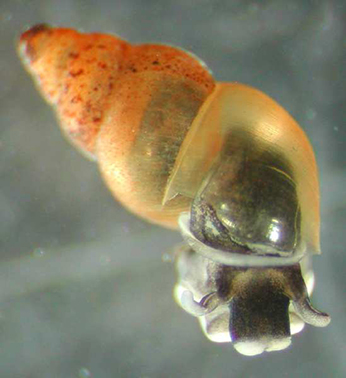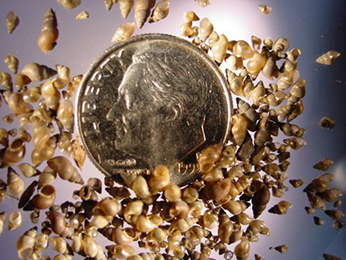(Potamopyrgus antipodarum)
General Description
 Close up image of a New Zealand mudsnail. Photo by Dan L. Gustafson.
Close up image of a New Zealand mudsnail. Photo by Dan L. Gustafson.
 New Zealand mudsnails with a dime for size reference. Photo by U.S. Geological Survey.
New Zealand mudsnails with a dime for size reference. Photo by U.S. Geological Survey.
New Zealand mudsnails (NZMS) are tiny, aquatic snails that reach, on average, up to 4-6 mm long in the western United States. The mudsnail has an elongated, right-handed coiling shell, usually consisting of 5-6 whorls, though some have up to 8. Shell color tends to vary from gray to light or dark brown. This species is ovoviviparous and parthenogenic, meaning they are live-bearers, which release live young rather than eggs, and those offspring are clonal (genetically identical) females that are asexually reproduced. When born, offspring already contain developing embryos within their reproductive system. Upon reaching maturity at 3 mm, females can produce 230 new females per year; estimates indicate that one snail and its offspring can result in over 2.7 billion snails within 4 years. Though sexually reproductive males (<5% of the population) and females do exist in their native range, the populations in the western U.S. are believed to contain only clonal females.
Current Distribution
As their name implies, these mudsnails are native to the rivers and lakes of New Zealand. In the U.S., they have been found in all western states, except New Mexico. In California, they are found in many lakes and river systems, including, but not limited to, the Owens, Klamath, Russian, Lower American, Stanislaus, Merced, San Joaquin, and Sacramento rivers, and many of their tributaries. In February 2016, NZMS were discovered in the lower Yuba and lower Feather rivers. For a detailed map, visit the United States Geological Survey's  Non-Indigenous Aquatic Species Database.
Non-Indigenous Aquatic Species Database.
Habitat Preference
NZMS are found on a wide variety of substrates and vegetation in fresh and brackish lakes, rivers, streams, and estuaries. They are tolerant of turbidity, siltation, and poor water quality, can reproduce in salinities up to 15 ppt, and can survive for short periods of time in salinities up to 35 ppt. Mudsnails can survive in water temperatures up to 93 °F, but do not to tolerate freezing temperatures. NZMS can also survive short periods of desiccation if in a cool, damp environment.
Pathways
In 1987, NZMS were first discovered in North America in the Snake River, Idaho. In 2000, they were found in the Owens River, California. It is believed that mudsnails were introduced to western rivers through shipments of live sportfish, but subsequent spread is likely due to recreational activities. Mudsnails easily attach to boots, waders, clothing, shoelaces, watercraft, aquatic vegetation, and gear, and can easily go unnoticed due to their very small size. As a result, they are commonly transported by unsuspecting anglers, boaters, other water recreationists, or even wildlife, including harvested fish. Mudsnails also disperse through floating freely or on algal mats, or by surviving passage through fish guts.
Impacts
Dense populations become the dominant macroinvertebrate through displacing and outcompeting native species; some North American streams have reached densities over ¾ million individuals/m2. They may consume up to half of the food resources in a stream and have been linked to reduced populations of aquatic insects, including mayflies, caddisflies, chironomids, and other insects important to trout and salmon. High density NZMS populations are likely to cause substantial negative impacts on fisheries by replacing preferred, nutritious foods. Vinson and Baker (2008) showed that (Green River, Utah) trout with NZMS in their guts had significantly poorer body conditions than those without. In feeding trials, rainbow trout fed an exclusive diet of unlimited NZMS passed 54% of mudsnails through the digestive tract alive, and subsequently lost up to 0.48% of their initial body weight each day, which is nearly equal to the impact of starvation.
Actions Taken if Found
If you observe this species in California, please report your sighting to the CDFW Invasive Species Program, or email us at Invasives@wildlife.ca.gov.
Additional Resources